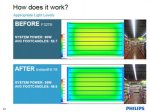Paul the BIG Finn
Member
- Location
- Ashburn, VA
We are being pitch a direct "LED Tube" replacement for our T8 fluorescents. You remove the old fluorescent lamp and install a "tube" of the same size which is really LED lights in a frosted tube. We have also been pitch a similar "LED Tube" that requires rewiring to bring 277V power directly through the lamp holder. They open the fixture, cut the power leads from the ballast and connect them to one of the lamp holders (the lamp holder on the other side is dead).
The "rewire" manufacturer claims the ballast will continue to burn energy, while the direct lamp replacement sales guy claims the ballast uses so little power the extra labor will never be paid for.
A couple of questions come to mind:
1. Both "tubes" put out less lumens than the fluorescent lamps they replace, but both sales guys claim all of the LED light is directed down and will deliver more light to the work plane. Is this true? Has anyone done an actual field test?
2. Both sales guys claim the LED "tubes are good for 50,000 hours and they "hardly ever burn out, just slowly emit less light. In my experience LEDs do last longer, but I have seen them just stop working. Is 50,000 hours reasonable? If it is the labor saving s will be as much as the energy savings.
3. The direct lamp replacement guy claims the lamp holder and internal wiring should be replaced if used for 277V, but the rewire guy claims replacement isn't required because the holders are "non-shuttered. Not sure why that makes a difference, but the wire inside the fixture is 18 AWG and the power wiring is 12 AWG. Shouldn't the wire to the lamp holder be 12 AWG?
4. Is it OK to abandon an unwired ballast in the light fixture or should we make them take them out?
Thanks,
The "rewire" manufacturer claims the ballast will continue to burn energy, while the direct lamp replacement sales guy claims the ballast uses so little power the extra labor will never be paid for.
A couple of questions come to mind:
1. Both "tubes" put out less lumens than the fluorescent lamps they replace, but both sales guys claim all of the LED light is directed down and will deliver more light to the work plane. Is this true? Has anyone done an actual field test?
2. Both sales guys claim the LED "tubes are good for 50,000 hours and they "hardly ever burn out, just slowly emit less light. In my experience LEDs do last longer, but I have seen them just stop working. Is 50,000 hours reasonable? If it is the labor saving s will be as much as the energy savings.
3. The direct lamp replacement guy claims the lamp holder and internal wiring should be replaced if used for 277V, but the rewire guy claims replacement isn't required because the holders are "non-shuttered. Not sure why that makes a difference, but the wire inside the fixture is 18 AWG and the power wiring is 12 AWG. Shouldn't the wire to the lamp holder be 12 AWG?
4. Is it OK to abandon an unwired ballast in the light fixture or should we make them take them out?
Thanks,

